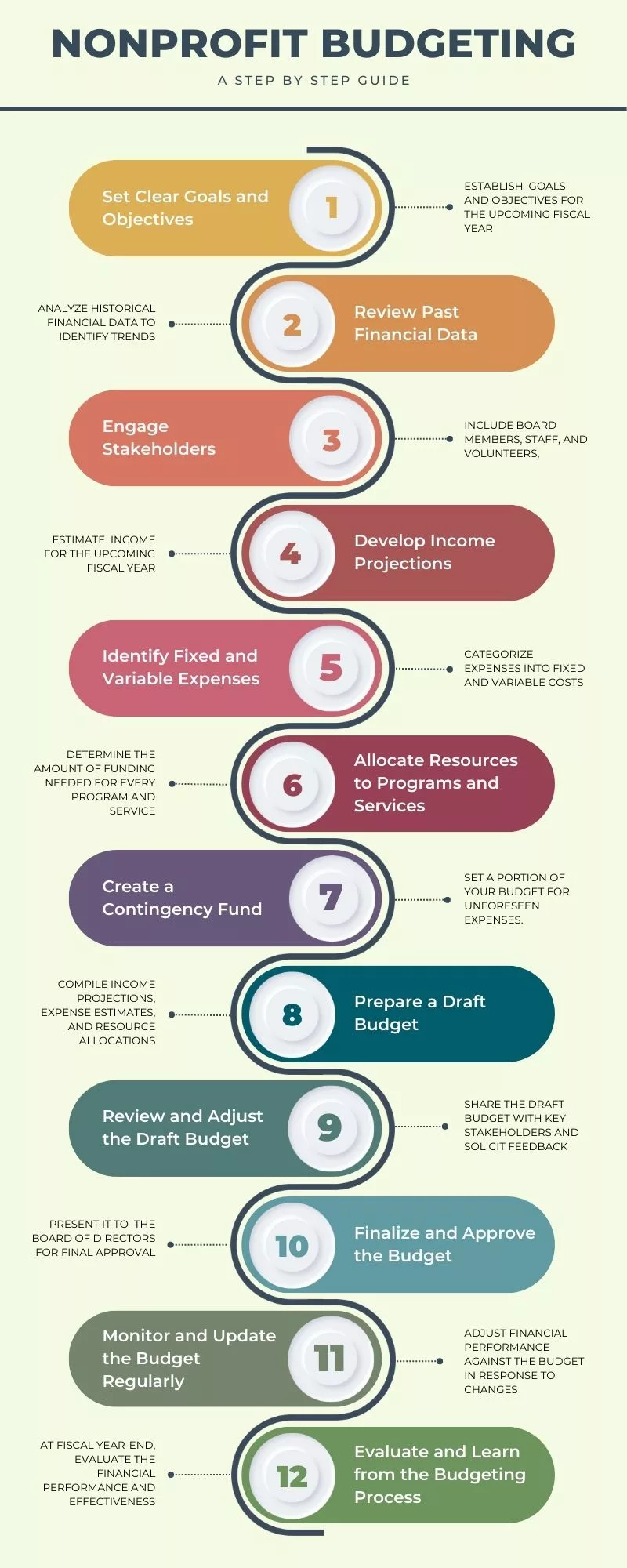Nonprofit budgeting is a strategic process, creating a financial roadmap for organizations. This detailed guide helps you allocate resources efficiently, presenting a holistic view of operating costs and expenses. The annual nonprofit budget illustrates the financial objectives to be achieved over a year.
Importance of Budgeting
The development of a nonprofit budget is fundamentally a strategic process. Once approved, the budget becomes an invaluable financial management tool for supervising ongoing operations and organizational activities throughout the year. For each reporting period, the organization assesses its actual performance in comparison to the initial plan, ensuring progress and financial stability.
Budgets serve several essential functions for nonprofits:
- Allocation of financial resources: Budgets help non-profit organizations prioritize their programs and activities, allocate funds to support them, and make informed decisions about resource allocation.
- Performance measurement and control: Budgets serve as a benchmark for assessing financial performance and identifying areas that require adjustments or improvements to match the objectives of the organization.
- Financial sustainability and planning: Effective budgeting enables organizations to plan for the future, ensuring they have the necessary resources to carry out their mission and achieve their primary goals.
Financial Health
Before diving into budgeting, it’s a good idea to look at your organization’s financial health. Financial health is critical because it demonstrates the organization’s ability to sustain its mission over time. The ability to keep operational expenses covered, maintain an adequate reserve fund, and have a plan for long-term financial stability are essential elements of a financially healthy nonprofit. Evaluating financial health involves several steps: reviewing financial statements, analyzing trends, and conducting a financial SWOT analysis.
Financial Management and Financial Documents
Financial management plays a crucial role in nonprofit budgeting, as it encompasses the processes of planning, organizing, controlling, and monitoring the organization’s financial resources. Key financial documents that inform the budgeting process and help monitor financial performance include:
- Income statements
- Balance sheets
- Cash flow statements
- Budget variance reports
These documents provide valuable insights into the organization’s financial health and performance, allowing nonprofit leaders to make informed decisions and adjustments as needed.
Step-by-Step Guide
Nonprofit budgeting is a crucial aspect of managing a nonprofit organization’s finances. It helps ensure that resources are allocated effectively to achieve the organization’s mission and goals. This step-by-step guide with practical details will help you create a well-structured and efficient nonprofit budget.

1) Set Clear Goals and Objectives
Before you begin budgeting, establish your organization’s goals and objectives for the upcoming fiscal year. Clearly defining these will help you allocate resources effectively and guide decision-making throughout the budgeting process.
2) Review Past Financial Data
Analyze your organization’s historical financial data to identify trends, recurring expenses, and potential areas for improvement. This will help you set realistic expectations and make informed decisions when creating your budget.
3) Engage Stakeholders
Include key stakeholders, such as board members, staff, and volunteers, in the budgeting process. This will ensure that everyone is aware of the organization’s financial position, goals, and priorities, and it will help create a sense of ownership and accountability.
4) Develop Income Projections
Estimate your organization’s income for the upcoming fiscal year, including grants, donations, membership fees, and any other revenue sources. Be conservative in your projections to avoid overestimating income and facing potential shortfalls later in the year.
5) Identify Fixed and Variable Expenses
Categorize your organization’s expenses into fixed and variable costs. Fixed costs are expenses that remain constant, such as rent or salaries, while variable costs fluctuate based on activity levels or other factors, such as utilities or event expenses.
6) Allocate Resources to Programs and Services
Determine the amount of funding needed for each of your organization’s programs and services. Keep your goals and objectives in mind when allocating resources, ensuring that they are aligned with your mission and priorities.
7) Create a Contingency Fund
Set aside a portion of your budget for unforeseen expenses or emergencies. This fund will provide a financial safety net and allow your organization to respond to unexpected events without jeopardizing its financial stability.
8) Prepare a Draft Budget
Compile your income projections, expense estimates, and resource allocations into a draft budget. Use a spreadsheet or budgeting software to organize the information, making it easier to review and adjust as needed.
ACCOUNTS by Software4Nonprofits is a specialized tool designed for non-profit organizations. It aids in preparing a budget by maintaining precise financial records, providing easy fund accounting that tracks revenues and expenses by program or grant, and offering budgeting features that allow for comparison of actual revenues and expenses against budget estimates. This ensures a comprehensive and accurate overview of an organization’s financial situation, facilitating effective budgeting.
Annual Budgeting
ACCOUNTS software facilitates the creation of annual budgets by providing a clear, organized platform. This helps non-profits plan their financial year efficiently, making it easier to compare actual income and expenses against the budget throughout the year.
Month-by-Month Budgeting
For organizations that experience significant fluctuations in income or expenses at different times of the year, ACCOUNTS provides the ability to create detailed month-by-month budgets. This feature allows non-profits to forecast and manage their finances according to expected seasonal variations. Whether it’s a major fundraising event in June, higher utility costs in winter months, or expected grant money in September, month-by-month budgeting helps organizations stay on track financially and make necessary adjustments in a timely manner.
Mid-Year Budget to Actuals Comparison Reports
The software also provides valuable real-time reporting, allowing for mid-year budget to actuals comparison reports. These reports offer insights into the organization’s financial health by showing how actual income and expenses line up with budgeted figures. If there’s a significant discrepancy, the organization can then investigate the causes and make necessary adjustments, ensuring financial stability and sustainability.
9) Review and Adjust the Draft Budget
Share the draft budget with key stakeholders and solicit feedback. Make adjustments as necessary to ensure that the budget aligns with your organization’s goals, priorities, and financial realities.
10) Finalize and Approve the Budget
Once the budget has been reviewed and adjusted, present it to your organization’s board of directors for final approval. Ensure that all stakeholders understand the budget and are committed to adhering to it throughout the fiscal year.
11) Monitor and Update the Budget Regularly
Track your organization’s financial performance against the budget throughout the year, making adjustments as needed to respond to changing circumstances. Regularly reviewing the budget will help you identify potential issues early and allow for more effective decision-making.
12) Evaluate and Learn from the Budgeting Process
At the end of the fiscal year, assess your organization’s financial performance and the effectiveness of the budgeting process. Use this information to inform future budgeting efforts and improve your organization’s financial management practices.
By following these steps, you can create a comprehensive and effective budget for your nonprofit organization, ensuring that resources are allocated in a way that supports your mission and maximizes your impact.
Example Nonprofit Budget
| Annual Total | |
|---|---|
| Income | |
| Individual Donations | $50,000 |
| Corporate Grants | $20,000 |
| Government Grants | $30,000 |
| Fundraising Events | $15,000 |
| Interest Income | $1,000 |
| Miscellaneous Income | $4,000 |
| Total Income | $120,000 |
| Expenses | |
| Salaries and Benefits | $60,000 |
| Rent and Utilities | $15,000 |
| Office Supplies | $5,000 |
| Fundraising Expenses | $10,000 |
| Program Services – Project A | $20,000 |
| Program Services – Project B | $6,000 |
| Travel and Training | $3,000 |
| Insurance | $2,000 |
| Miscellaneous Expenses | $2,000 |
| Total Expenses | $123,000 |
Different Budgeting Techniques
There are several budgeting systems and techniques that nonprofits can adopt, each with its unique advantages and drawbacks. Some of the most common methods include:
- Line-item budgeting: A traditional approach that organizes expenses by category (e.g., salaries, rent, supplies). This method provides a clear view of where funds are being allocated but may not effectively link spending to program outcomes.
- Program budgeting: This method organizes expenses by program or project, making it easier to evaluate the cost-effectiveness of each initiative and assess its impact on the organization’s mission.
- Zero-based budgeting: Requires justification for each expense, promoting efficient resource allocation and cost control. However, this approach can be time-consuming and may not be suitable for all organizations.
- Incremental budgeting: Builds on the previous year’s budget, adjusting for inflation, new initiatives, or other factors. This method is simple to implement but may not encourage innovation or strategic thinking.
- Performance-based budgeting: Links funding to performance outcomes, incentivizing efficiency, and effectiveness. However, it may be challenging to implement for organizations with complex or hard-to-measure outcomes.
Conclusion
Effective budgeting is essential for the success of any nonprofit organization. By exploring various budgeting techniques, systems, and best practices, nonprofit leaders and board members can develop a deeper understanding of the budgeting process and its functions. This knowledge will empower them to make strategic financial decisions that support the organization’s mission, promote financial sustainability, and ensure a lasting impact on the communities they serve. So, go ahead and dive into the world of nonprofit budgeting with confidence!



